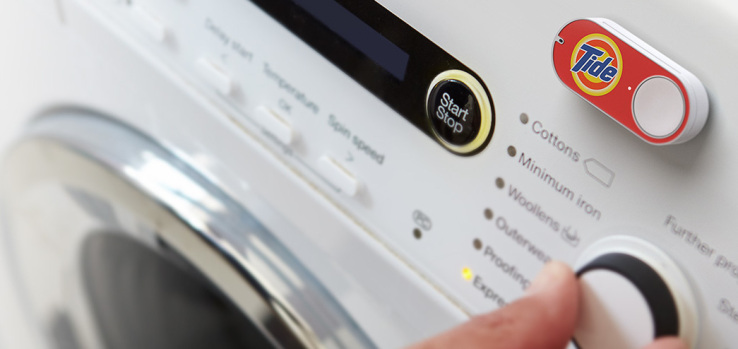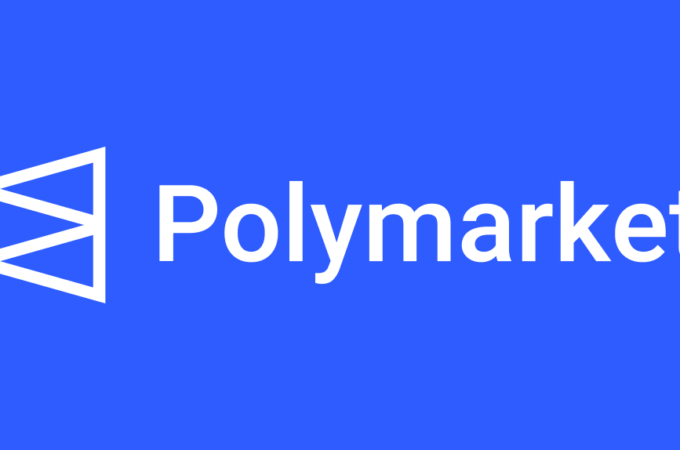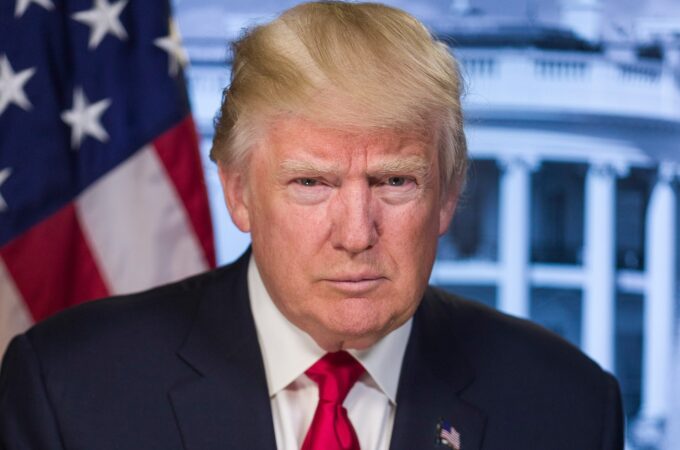
Amazon Has Invented Tiny Plastic Buttons That Allow For Instant Product Ordering
THE VERGE: Amazon is rolling out new hardware today called the Dash button that promises to solve these scenarios. It’s a small physical button that you can stick wherever, and press when you want to order more of something. Need more diapers? Hit the diaper button. Need more toilet paper? Just hit the toilet paper button. Find yourself running low on mac and cheese, razor blades, Gatorade, or laundry detergent? There is now a button for each one of those things. The future where you can just be lazy and spend money with a push of a button from Amazon is here, and it’s very real.
The Dash button is not to be confused with a separate piece of food-ordering hardware called Dash, which scans product barcodes and lets people speak orders into Amazon Fresh. Instead, it’s a much smaller Wi-Fi-enabled button that will instantly order a predetermined product within seconds of pressing it. Amazon already has your credit card information on file, and knows what size and quantity you want, so two days later, that product shows up at your house. A little multi-colored LED on the front of it will blink after you press it, then turn green to let you know it worked.
Dash buttons can be stuck just about anywhere with an adhesive strip that’s on the back, though they are not magnetic. Amazon also gives you a small bumper that can go around it and allow it to be hung up on hooks or on strings. Some smarts have been included in its programming, so that if you or someone else hits the button more than once, it won’t reorder until that same product has been delivered to your house. You can also turn this feature off — at your own peril — in Amazon’s mobile phone app.
Amazon is launching the Dash buttons with 18 different partners today, and they’re free if you’re a Prime Member. You don’t get to use it on just any product onAmazon.com though. Each button is tied to a brand, or to be more specific, a product from a brand. You can, for instance, get a button for diapers, but it’s only for Huggies. If you’re a Pampers person, you’ll still have to order the old-fashioned way.
But it might not be that way forever. Along with buttons, Amazon is launching what it calls the Dash Replenishment Service, which is ultimately designed to do away with the buttons entirely. Companies that make products can bake this technology into their own hardware: things like coffeemakers, washer/dryers, printers, and pet food dispensers. It’s not so great for household goods like paper towels, but Amazon is betting that eventually these sensors will get so small and cheap to make, that you could have them in individual products too.
In the meantime, a few of the first products to embed the replenishment service are ones that are not leaving your house. New York-based Quirky has designed a pour-over coffee maker (see the image to the right) that keeps track of both its bean reservoir and your filter supply. Get too low on beans, and you can have it set to automatically reorder for you. Coffee aficionados might scoff at that, but that system could be ideal in offices. Similarly, Quirky has come up with both pet food and baby formula dispensers that keep track of how much supply you have left and will reorder when it notices you’re low. These same ideas are being implemented in washers from Whirlpool, printers from Brother, and filtered water pitchers from Brita.
Amazon’s new platform will also let other companies create similar types of products. It’s not supplying the sensors, but it is providing what it says is a very simple back end through Amazon Web Services that does the heavy lifting of taking the order, processing the payment, and fulfilling it. Amazon won’t say what the business arrangement is between it and companies that want to get in on this, though it’s clear that its pitch is repeated business from Amazon customers who might end up keeping these buttons and integrated devices in their homes for years to come.
There are a few obvious gaps and shortcomings where Dash buttons are less than ideal, especially where the Dash replenishment system has been integrated into hardware. The coffeemaker is a good example. Coffee enthusiasts like to keep their beans as fresh as possible, and will often change the roast they’re buying between bags. They also buy from a variety of sources, making the Dash implementation less useful there.
Another issue is that the size, price, and availability of Prime-eligible products can frequently change on Amazon. Sometimes that means a multi-pack of something can become markedly cheaper, or make the product you buy considerably more expensive. Longtime users of Amazon’s “subscribe and save” service also tend to get better deals on recurring purchases on the very same types of products where Dash buttons would make the most sense, but Dash isn’t able to optimize for price changes, at least not right now. Amazon is keen to note that you have some time after orders have been made to make adjustments, and that Dash button purchases can be more sporadic than ones made with its subscribe and save service.
Amazon has been testing Dash buttons in hundreds of homes for the past year, about how long its Dash scanner hardware for Amazon Fresh has existed. The key difference is that this is open to a potentially much larger group than the food delivery service, which currently runs $299 a year and exists only in Seattle, parts of California, and New York. It also removes an entire step in the process by letting you buy things instantly, whereas Dash requires you to log into Amazon from your phone or computer to verify and order. That ease of spending money may be scary to some, but Amazon is betting that, for the types of people who buy the same things over and over again, this is exactly what they want.
Taking a step back, Amazon Dash buttons and the service that powers them are perhaps the clearest example of where human ingenuity intersects with laziness. We used to have to hunt and kill our food, or at least walk to the store and buy it. Now we just need to fumble for a button in the dark.
Read more on the topic: TECHCRUNCH, THE NEXT WEB





